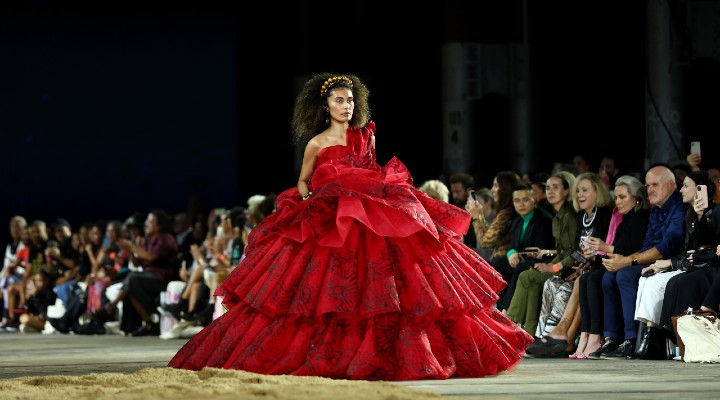Last week, Breville revealed a range of six kitchen products featuring Aboriginal artworks from three Western Desert artists from the Papunya Tula Artists Centre, with 100 per cent of profits going to First Nations foundations and the artists owning their own copyright. It’s just one of many Indigenous collaborations mainstream brands are now embarking upon, from Wittner’s Winyaar collection with First Nations artist Alkina Edwards to Adairs’ range with Miimi and Jiinda. During an in-depth
-depth discussion during Afterpay Australian Fashion Week, several Indigenous leaders across different industries shared their insights on First Nations representation in the fashion industry and the connection between their art, community and culture. Here are some of the key takeaways from their conversation.
Fashion as a vehicle to tell stories
At a time when many brands are now focused on creating narratives to build connections with customers, the industry simply needs to turn to Indigenous designers, whose work is centred on sharing their history and stories. In the future, Mayor Phillemon Mosby from the Torres Strait Islander Council believes there’s an opportunity for the wider sector to embrace this work so that it’s embedded within the mainstream Australian fashion industry.
“It’s an opportunity not only for fashion designers, but it’s a moral obligation to this country and the people of this country to capture these stories…it draws people closer to the spirit of this place,” he said.
“Our culture is very verbal, it’s not written, it’s more expressed in what you see and I think fashion really is a perfect opportunity to be able to carry those stories. Many people talk about narrative and there are fashion lines that connect you to different things, but in First Nations cultures, it’s about authenticity, it brings a sense of ownership in fashion and a sense of diligence. People don’t rush into things, they observe things and let things speak to them.”
It’s cyclical
As artist Neil Morris explained, for Indigenous artists and talent, design is linked to culture and community at “a grassroots level”. The work that one Indigenous person creates flows “right down to Indigenous communities and helps to uphold Indigenous culture, which actually leads to powerful design”.
“Whichever angle you look at it, they all inform and influence the development of one another,” he said. “Coming back to manufacturing, we need investment in grassroots Indigenous communities to keep an Aunty creating beautiful things who wants to live on country. We need investment so mob can become high-end designers.”
Thinking of a collab with an Indigenous artist? Listen in
While it’s encouraging that mainstream non-Indigenous brands want to partner with First Nations artists and designers, it’s imperative that the retailer understands the story behind the artist, his or her community and history before launching into a collaboration.
“If I was an Indigenous designer and a larger brand was to come to me, I’d want them to know my story. Spend time with me, have a yarn with me in person with no cameras around, just sit and talk to me and get to know me and see if my story is really what you want to tell,” explained model Sené Maluwapi.
“In Black culture, we’re storytellers. Every form of art we give tells a story. If you want to give us a platform, are you willing to hear that story?
“Mob – we see each other as family. We’re all different, we come from different parts of Australia and different tribes, but when we come together, we connect, and it should be the same for non-Indigenous mob. Listen to my story and get to know my culture. It’s an important factor that is forgotten a lot unfortunately.”
Following on from that, brands should avoid making tokenistic efforts only around specific calendar dates, such as Reconciliation Week.
“First Nations collabs tend to come around during NAIDOC Week and I don’t think brands realise how tokenistic it feels to the individual,” Maluwapi said.
First Nations talent agent Bianca Hunt also asked for brands to show more cultural sensitivity when approaching an Indigenous person to work with them.
“Years ago, I was completely booked out during NAIDOC Week. I was overworked and I was exhausted. Sometimes, I don’t think brands see it’s a big week for us and we’re meant to be celebrating our survival during that period of time. As good as it is to see collaborations, it can be really exhausting,” she revealed.
“Blackfellas are thriving”
This is the second year that Afterpay Australian Fashion Week has embraced the Indigenous community by featuring shows from Indigenous Fashion Projects and First Nations Fashion and Design, hosting a Welcome to Country and panel discussions with Indigenous talent.
“To see us strutting through this place, honestly, it gives you goosebumps, it makes you feel really proud, it makes you feel seen, heard and represented,” said Mosby.
For content creator and plus-size model Allira Potter, it’s a long-awaited shift in the industry.
“Walking through Fashion Week and seeing mob – it’s unreal. It’s so cool. It’s almost a relief for me, thinking, why hasn’t this been done years ago? But here we are now and having this conversation and it’s so powerful. When I was asked to do this panel, I thought, ‘Why?’ because we’ve never had that representation. But here we are, we’re showing up and we’re finally taking up as much space as we possibly can,” she said.
“Blackfellas are thriving and I can only imagine [what will happen in] the next couple of months and years. The sky’s the limit and by working in the fashion industry and working with massive brands, I’m challenging the norm. Finally, we’re seeing Black representation in these spaces, which is unreal.”

